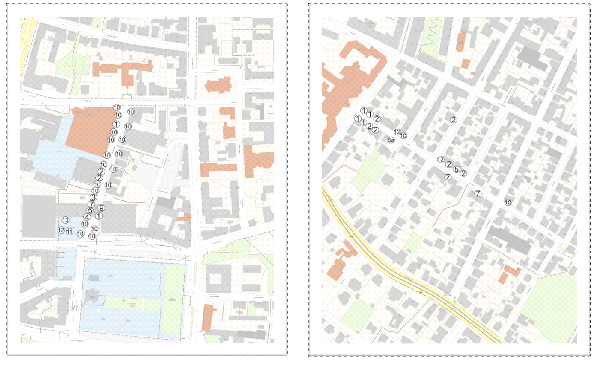Parking Management for the central city area – the case of Bielefeld
Edited on
24 August 2022As early as 2019, the Bielefeld City Council decided in its mobility strategy to halve the share of motorised private transport in total traffic from currently around 50% to 25%, thus setting the course for Bielefeld's development into a modern and liveable city. In the adopted strategy, guiding principles and recommendations for action were drawn up, which serve as a planning principle and set the scene for all coming strategies, plans and actions. These guiding principles of the mobility strategy refer to the changed perception of society regarding the protection of climate and the sustainability of planning, they promote intergenerational justice and are therefore of essential importance for an attractive and future-oriented urban development.

Challenges
The city areas with the highest need for action are central areas and the inner city itself. Their development present major challenges for many German cities. Inner cities should be a lively centre for trade and gastronomy, for accommodation, leisure, work, living, culture and education. They should be easily accessible and at the same time address urgent issues such as climate protection and public health. The interests and expectations in urban societies are correspondingly diverse and at least partially opposed to each other. However, this does not reduce the pressure to act: instead, cities are required to find a development strategy for the city centre that reconciles various functions and interests as well as overriding necessities.
Objectives
For Bielefeld, an important component of the sustainable mobility strategy is to create attractive alternatives to private cars, which in turn is an important prerequisite for shifting car journeys to walking, cycling and public transport and ultimately a reduction in car traffic. A significant factor in favour of using the car is the generously available infrastructure for parking. Bielefeld consequently put emphasis on assessing the state of play for car parking in its central areas such as city districts and the inner city to formulate objectives on the availability of car parking and its use conditions supporting the modal shift as set out in the city-wide mobility strategy.
In action
In Space4People, car parking in Bielefeld was extensively surveyed in the city district centres, on park & ride facilities and in selected car parks. To achieve the needed change in mobility among the population, measures were developed in the present concept and assessed with regard to their effectiveness. The result of the study shows that a successful change in modal choices and the achievement of the set goals can only be achieved through a combined push and pull strategy, and not with supportive measures to sustainable mobility options alone.
As a consequence of the analysis phase, Bielefeld aims to elaborate a comprehensive parking strategy working as an integral part to its urban mobility policy. A certain focus of the planning process is put on the high-use zones and general changes to the on-street parking conditions. The work for the parking strategy includes elements such as:
- Create fair on-street parking pricing models
- Reduction of on-street parking spaces in central areas globally
- Work with off-street parking providers to attract more customers in order to enable further reduction of on-street parking supply
- Integration of parking measures into SUMP measure packages to increase their impact and make use of a push & pull approach
- Communication and campainigng to change perceptions and modal choices of residents & commuters
- Elaborate customer (parking) strategy with inner city retailers
- Public communication campaign to explain changed parking policy
- Define, test and plan pedestrianisation projects / mixed-use road designs to improve user experiences of public space
Considering the results of the analysis of car parking in Bielefeld, the city council decided in December 2021 that the following topics should be developed by summer 2022 in citizen participation and political advice:
- Reduction of parking space
- Transit bans
- Lane reduction
- Reduction of the maximum permitted speed
- Adjustment of street parking fees
The focus of the work was put on the inner-city area to develop a parking management strategy for the most pressed area of the city. The intervention area was formulated in four sub-areas: the main rail station (in green), the square Kesselbrink (in brown), the old town (in grey) and the provincial court (in light green).

The participative planning process employed a set of measures. The start were direct stakeholder consultations which were followed by two public participation events, one covering two of the above areas each. They used a mix of a lecture by an environmental scientist with extensive co-work parts on four overarching questions broken down to develop details ideas for each defined area. Summarised, participants differentiated the necessity for on-street parking streetwise to a large variety ranging from dropping all, keeping some, to keeping all. Argumentations made use of the presented occupancy rates in the areas and included more specific settings like favouring residential parking for on-street spaces and catering for access needs to medial centres. The biggest challenges were the need for residential parking and bicycle parking in general, missing CarSharing concepts, the need to better exploit off-street capacities as well as loading vehicles and e-scooters blocking public space. Concerning specific elements needed for the four areas, most claims were to add residential parking, charging options for e-vehicels, specific parking zones for (shared) bicycles and loading / unloading as well as more greeneries, outdoor furniture, and water elements. Workshop participants located their suggestions to streets of the four areas as visible in the maps below.
The area around the main station and the souther part of the Old Town

The area around the "Kesselbrink" square and the Regional Court area

The in-person workshops were supplemented by an online participation element at a specific project website. Any website user could place their suggestions following the four main areas of car parking, biycle parking, alternative services for parking and non-transport public space use to online maps of the four inner-city areas. Each suggestion could be commented for further details. Suggestions focused on residential parking, its pricing and location as well as off-street parking connected to pricing in general, adding more and better-quality bicycle parking options and better cycling infrastructure, improving traffic management for loading / unloading, e-scooters and improved traffic flow as well as adding more greeneries, outdoor furniture and a stop to show-off cruising.
Conclusions
The actions take a two-fold dimension with work tasks allocated with the city administration, department for traffic, at the next steps:
- First, administration will perform an in-depth analysis e.g., localising the next actions on the workshop results to propose a detailed concept for the parking strategy for the inner-city. The concept is presented to public stakeholders as well as to political decision makers.
- Second, administration elaborates on the core principles for the parking strategy city-wide which complement the actions for the inner-city area. Actions planned focus on:
- Simplify parking zoning to one zoning scheme using concentric ring areas reaching out from the old town area.
- Setting a pricing model with 3-4 price steps being highest in the centre and getting cheaper the further the zone is located from the centre. Proposals for pricing are €5 at the centre and €4 in city district centres and general pricing levels of the ring zones using €1 steps. The pricing will not touch the outer residential districts.
- Increase pricing for residential parking from € 30 per year to e.g., a model of € 1 per day = € 365 per year
- Work with parking garage operators to exploit free capacities at price level of on-street parking or below.
Public presentation and consultation as well as political decision-making is scheduled to take place directly after the summer break in autumn 2022.
Lessons learnt
The results are showing that a successful change in mobility and the achievement of the set goals can only be achieved through a combined push and pull strategy. The measures relate to car parking must be tailored to the respective local situation.
Cities should be open to new ways of planning and to experiment with new measures, also to those that seem out of the local frame at the first glance. Cities should try to dedicate external experts analysing and then eventually implementing these measures that seem to be out of place. Cities should avoid conservative and static planning approaches.
Submitted by Claus Kollinger on
